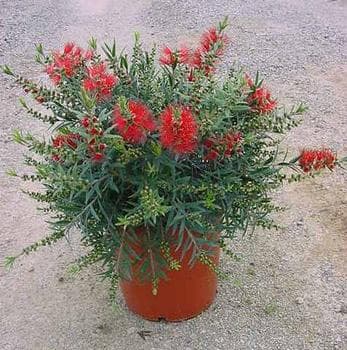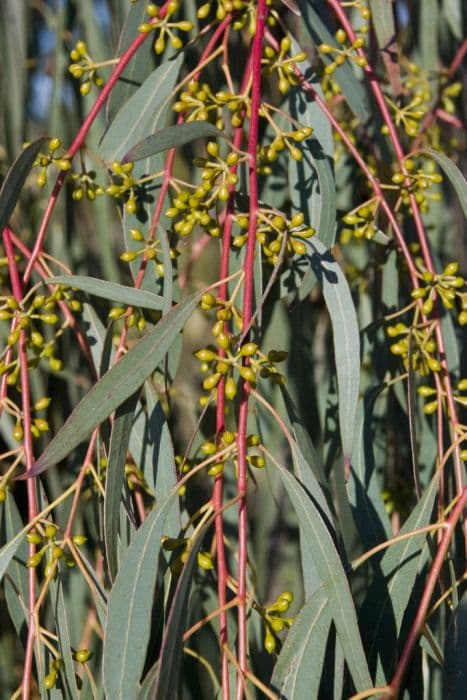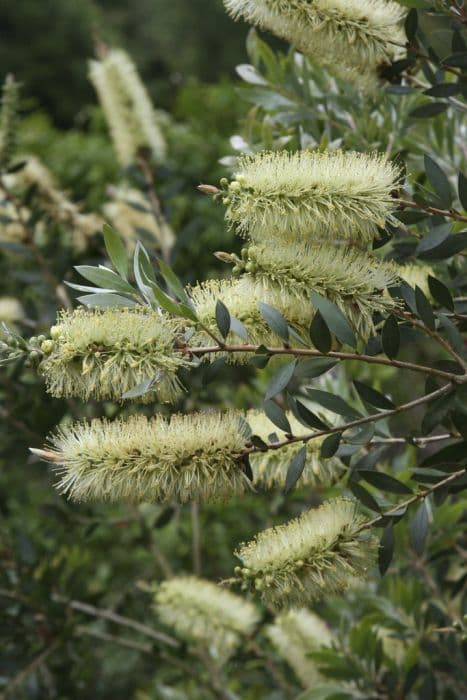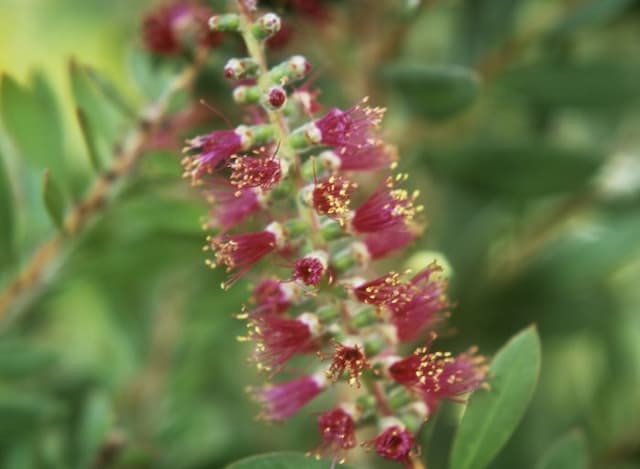Small-leaved Gum Eucalyptus parvula

ABOUT
Eucalyptus parvula, commonly known as the small-leaved gum, has a distinct and attractive appearance. This plant is characterized by its beautiful, fibrous bark which peels away in strips to reveal a smooth, cream to grey surface beneath. The leaves of the small-leaved gum are a notable feature. They are rounded to heart-shaped when young, lending a soft and lush texture to the foliage. As the plant matures, the leaves elongate, becoming lance-shaped and taking on a bluish-green hue, with a waxy or glossy finish that catches the light. During the blooming season, the small-leaved gum produces clusters of fluffy white flowers that emerge from distinct button-like gumnuts. These flowers are striking in contrast to the foliage, attracting various birds and insects. The overall shape of the plant is typically multi-stemmed, forming a dense and spreading habit that provides a broad canopy, while the branches sometimes exhibit an attractive, twisted growth pattern. The visual appeal of the small-leaved gum is enhanced by its evergreen nature, as it retains its foliage year-round, providing continual interest and color in the landscape.
About this plant
 Names
NamesFamily
Myrtaceae.
Synonyms
Small-leaved Gum, Kybean Gum, Alpine Snow Gum, Small-fruited Gum.
Common names
Eucalyptus parvifolia, Eucalyptus parvula var. parvula.
 Toxicity
ToxicityTo humans
The small-leaved gum is generally recognized as non-toxic to humans. However, eucalyptus oil, which can be derived from the leaves, is poisonous if ingested in large quantities. Symptoms of eucalyptus poisoning include abdominal pain, nausea, vomiting, diarrhea, dizziness, or muscle weakness. In severe cases, it can cause central nervous system depression and respiratory difficulty.
To pets
Small-leaved gum is considered toxic to pets, especially cats and dogs. If a pet ingests the leaves or oil of this plant, they can experience symptoms such as salivation, vomiting, diarrhea, depression, and weakness. In large amounts, eucalyptus can cause central nervous system depression and may be fatal to pets. It is important to prevent pets from chewing on or consuming any parts of this plant.
 Characteristics
CharacteristicsLife cycle
Perennials
Foliage type
Evergreen
Color of leaves
Blue-green
Flower color
White
Height
20-30 feet [6-9 meters]
Spread
10-15 feet [3-4.5 meters]
Plant type
Tree
Hardiness zones
8
Native area
Australia
Benefits
 General Benefits
General Benefits- Drought Tolerance: Eucalyptus parvula, commonly known as Small-leaved Gum, can endure periods of dryness once established, making it suitable for regions with low rainfall.
- Cold Hardy: Small-leaved Gum is capable of withstanding colder temperatures than many other eucalyptus species, allowing it to grow in cooler climates.
- Ornamental Value: With its attractive peeling bark and blue-green leaves, it adds aesthetic value to landscapes.
- Wildlife Habitat: Provides shelter and food for birds and insects, supporting local biodiversity.
- Low Maintenance: Once established, Small-leaved Gum requires minimal care, reducing the need for water, fertilizers, and pesticides.
- Fast Growth: Eucalyptus parvula is known for its rapid growth rate, making it a quick solution for those wanting to establish a presence in the landscape in a short time.
- Erosion Control: Its root system helps to stabilize the soil, which can prevent erosion in certain environments.
- Shade Provider: With its broad canopy, Small-leaved Gum offers shade to underplantings and can reduce temperatures in urban environments.
- Windbreak: Often used in plantings to act as a windbreak, protecting other plants and reducing wind erosion.
 Medical Properties
Medical Properties- Antiseptic: Eucalyptus parvula contains compounds that are known for their antiseptic properties and might help in treating cuts and wounds.
- Decongestant: The foliage may produce oils that can assist with congestion and respiratory issues when inhaled.
- Anti-inflammatory: Components in the plant may have anti-inflammatory effects that could aid in reducing inflammation.
- Analgesic: The plant is sometimes considered for its pain relief potential due to certain eucalyptus species known to possess analgesic properties.
- Antimicrobial: Eucalyptus parvula might have antimicrobial effects which can be beneficial in fighting certain bacteria and viruses.
 Air-purifying Qualities
Air-purifying QualitiesThis plant is not specifically known for air purifying qualities.
 Other Uses
Other Uses- Insect Repellent: The oil from the small-leaved gum can be used in natural insect repellent formulations to ward off mosquitoes and other pests.
- Woodworking: The dense, robust wood of small-leaved gum is valued for its woodworking potential, often used in the creation of fine furniture and craft objects.
- Essential Oils: Though not medically, the oil for its aroma is used in aromatherapy for stress relief and relaxation, without reference to its health benefits.
- Ornamental Use: With its attractive form and foliage, small-leaved gum serves as an ornamental plant in gardens and parks.
- Dye Production: The leaves and bark of small-leaved gum can yield natural dyes for textile coloring, providing various shades of browns and reds.
- Windbreaks: Its dense foliage makes it an excellent choice for creating windbreaks on farms or in landscapes susceptible to high winds.
- Erosion Control: Because of its robust root system, small-leaved gum helps stabilize soil and prevent erosion on slopes and embankments.
- Mulch: Leaves and bark can be mulched to enrich soil with organic matter and protect roots of other plants in extreme temperatures.
- Floristry: Eucalyptus branches and leaves are commonly used in floral arrangements and bouquets for their unique texture and scent.
- Perfumery: Oil from small-leaved gum can be found in perfumery, providing a fresh, clean scent to various fragrances.
Interesting Facts
 Feng Shui
Feng ShuiThe Small-leaved Gum is not used in Feng Shui practice.
 Zodiac Sign Compitability
Zodiac Sign CompitabilityThe Small-leaved Gum is not used in astrology practice.
 Plant Symbolism
Plant Symbolism- Healing: Eucalyptus parvula, commonly known as small-leaved gum, often symbolizes healing because its oil is known for medicinal properties, particularly as a decongestant and antiseptic.
- Protection: Historically, eucalyptus is believed to ward off bad spirits and illnesses, thus representing protection.
- Cleansing: The plant is associated with cleansing due to its refreshing scent and the belief that it can clear negative energy.
- Renewal: Small-leaved gum also signifies renewal because eucalyptus trees are adept at regenerating after fires, which is seen as a metaphor for new beginnings.
 Water
WaterThe small-fruited eucalyptus requires deep watering every two to three weeks during the summer or more often during periods of extreme heat or drought. During the winter or cooler months, reduce watering to once a month or less, ensuring the soil has dried out completely before watering again. When watering, use approximately 1 to 2 gallons of water depending on the size of the plant and the dryness of the soil, making sure to saturate the root zone thoroughly. Avoid overhead watering to minimize wetting the foliage, which could lead to fungal diseases. Adjust the quantity of water considering rainfall and seasonal changes throughout the year.
 Light
LightThe small-fruited eucalyptus prefers full sun conditions and thrives in a location where it can receive at least six to eight hours of direct sunlight daily. It is best planted in a spot away from shade-casting buildings or trees to ensure it receives ample light for healthy growth and development. Adequate sunlight helps maintain the plant's natural shape and promotes the production of its fragrant, aromatic oils.
 Temperature
TemperatureThe small-fruited eucalyptus is hardy and can withstand temperatures as low as 20°F but thrives best in climates where the temperature ranges between 60°F to 80°F. It can tolerate occasional frosts but extended exposure to temperatures below 20°F may damage or kill the plant. Optimal growth occurs in areas where the temperature does not dip below freezing too frequently in the winter months.
 Pruning
PruningRegular pruning of the small-fruited eucalyptus is necessary to shape the tree, encourage bushier growth, remove dead or damaged branches, and promote overall health. Prune in late winter or early spring before the onset of new growth. This timing minimizes the risk of pest infestation and disease associated with fresh cuts. Light pruning can be done annually, but major structural pruning should be done less frequently, only as needed.
 Cleaning
CleaningNot needed
 Soil
SoilFor the Eucalyptus parvula, commonly known as Small-leaved Gum, the best soil mix is well-draining with added sand or perlite, and low fertility. It thrives in slightly acidic to neutral pH, ranging from 5.5 to 7.
 Repotting
RepottingSmall-leaved Gum should be repotted every few years as it grows rapidly. Young plants benefit from annual repotting, while mature plants can be repotted every 2-3 years.
 Humidity & Misting
Humidity & MistingSmall-leaved Gum prefers low to moderate humidity levels; too high humidity can promote fungal diseases.
 Suitable locations
Suitable locationsIndoor
Use large pot, well-draining soil, bright light for Small-leaved Gum.
Outdoor
Plant in full sun, well-drain soil, protect from wind for Small-leaved Gum.
Hardiness zone
8-10 USDA
 Life cycle
Life cycleEucalyptus parvula, commonly known as the small-leafed gum, begins its life cycle as a seed, typically germinating in moist, well-drained soil conditions. Upon germination, a small seedling emerges and enters a juvenile phase characterized by rapid growth and the development of lanceolate (spear-shaped) leaves, which are initially opposite, sessile, and bluish-green. As it matures, the small-leafed gum transitions to its adult form, growing a straight trunk with peeling bark and producing elongated, pendulous adult leaves that are more distinctly eucalyptus-like in appearance and aroma. During the flowering stage, the plant produces clusters of white flowers that are rich in nectar, attracting a variety of pollinators. Following pollination, the flowers develop into woody fruits or capsules, which release seeds when they mature, completing the reproductive cycle. The Eucalyptus parvula will experience several flowering and seeding cycles throughout its lifespan, potentially living for several decades under suitable environmental conditions.
 Propogation
PropogationPropogation time
Spring to Summer
Eucalyptus parvula, commonly known as the small-leaved gum, is often propagated through seed sowing. The most popular method involves collecting the seeds from mature capsules and sowing them in a well-draining seed-raising mix. This is usually done in late winter to early spring to take advantage of the warmer temperatures that stimulate germination. Seeds should be sprinkled onto the surface of the soil and lightly covered with a fine layer of sand or seed-raising mix to avoid burying them too deeply. Consistent moisture and warmth are crucial, so maintaining a humid environment, for example by covering the seed tray with a plastic dome, is beneficial until germination occurs, which is typically in a few weeks to a couple of months. Seedlings are then potted on into individual containers once they are large enough to handle.









